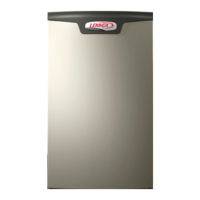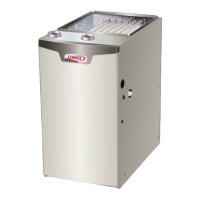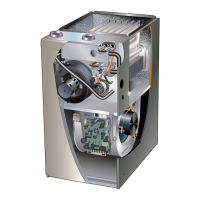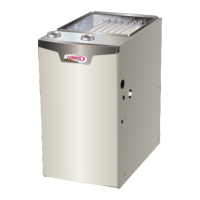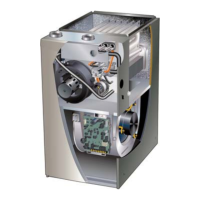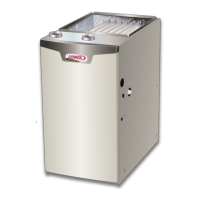Page 6
Safety Precautions
If you discover any of the following, shut down your
unit, and contact a Lennox dealer for an inspection by
a licensed professional service technician (or equiv-
alent).
• If you repeatedly hear any new or unfamiliar sounds
while your unit is operating, there may be a problem.
For example, poorly performing burners can produce
unfamiliar noises.
• If you smell any unusual odors, your unit may be op-
erating mproperly. For example, units can give o un-
familiar odors if components are required to operate in
abnormal conditions.
• Look for visible signs of a malfunctioning unit. Exam-
ples nclude unusual amounts of condensate on win-
dows inside your house, visibly burnt components or
unusual dirt or rust accumulations on the vent pipe or
in the unit.
• If you experience headache, nausea, fatigue, or diz-
ziness, the cause could be exposure to carbon mon-
oxide gas. This is often misdiagnosed as the u be-
cause symptoms are similar. If you suer from u-like
symptoms that are exaggerated at home, but seem to
subside while you are away from the house, exposure
to carbon monoxide could be the cause.
WARNING
Do not use this furnace if any part has been
underwater. A ood-damaged furnace is extremely
dangerous.
Attempts to use the furnace can result in re or
explosion. Immediately call a licensed professional
service technician (or equivalent) to inspect the
furnace and to replace all gas controls, control
system parts, and electrical parts that have been
wet or to replace the furnace, if deemed necessary.
Your vigilance may pay o in early detection of a problem
before either personal injury or property damage occurs.
Do not hesitate to contact a licensed professional service
technician (or equivalent) as an investment in your well
being.
Planned Service
Annual Furnace Maintenance
At the beginning of each heating season, and to comply
with the Lennox Limited Warranty, your system should
be checked as follows by a licensed professional service
technician (or equivalent).
1 - Check wiring for loose connections, voltage at
indoor unit and amperage of indoor motor.
2 - Check the condition of the belt and shaft bearings
if applicable
3 - Inspect all gas pipe and connections for leaks.
4 - Check the cleanliness of lters and change if
necessary (monthly).
5 - Check the condition and cleanliness of burners and
heat exchanger and clean if necessary.
6 - Check the cleanliness of blower assembly and
clean the housing, blower wheel and blower motor
if necessary.
7 - Inspect the condensate drain and trap for leaks and
cracks. The drain and trap must also be cleaned
and the trap must be primed with water. Inspect the
rubber hoses connected to the pressure switches for
cracks or loose connections, replace as necessary.
Remove the rubber hoses from the cold end header
box and inspect for any blockage, clean as needed.
If strainers are installed in the hoses remember to
remove and clean before reinstalling the hoses.
8 - Evaluate the heat exchanger integrity by inspecting
the heat exchanger per the AHRI heat exchanger
inspection procedure. This procedure can be
viewed at www.ahrinet.org
9 - Ensure sucient combustion air is available to the
furnace. Fresh air grilles and louvers (on the unit
and in the room where the furnace is installed)
must be properly sized, open and unobstructed to
provide combustion air.
10 - Inspect the furnace intake and exhaust pipes to
make sure they are in place, structurally sound,
without holes, blockage or leakage and the
exhaust pipe is sloped toward the furnace. Inspect
terminations to ensure they are free of obstructions
and are structurally sound. Inspect the furnace
return air duct connection to ensure the duct is
sealed to the furnace. Check for air leaks on supply
and return ducts and seal where necessary.
NOTE - After any heavy snow, ice or frozen fog event the
furnace vent pipes may become restricted. Always check
the vent system and remove any snow or ice that may be
obstructing the plastic intake or exhaust pipes.
11 - Inspect the furnace return air duct connection to
ensure the duct is sealed to the furnace. Check for
air leaks on supply and return ducts and seal where
necessary.
12 - Check the condition of the furnace cabinet insulation
and repair if necessary.
13 - Perform a complete combustion analysis during the
furnace inspection to ensure proper combustion
and operation. Consult Service Literature for proper
combustion values.
14 - Verify operation of CO detectors and replace
batteries
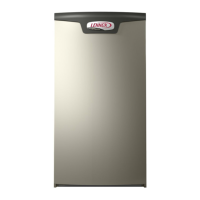
